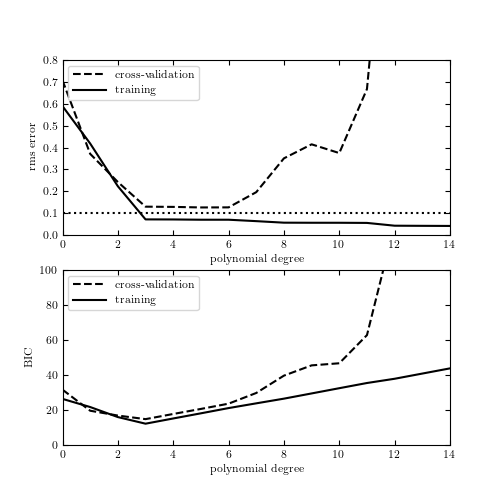Cross Validation Examples¶
Figure 8.14
The top panel shows the root-mean-square (rms) training error and validation error for our toy model (eq. 8.75) as a function of the polynomial degree d. The horizontal dotted line indicates the level of intrinsic scatter in the data. Models with polyno- mial degree from 3 to 5 minimize the validation rms error. The bottom panel shows the Bayesian information criterion (BIC) for the training and cross-validation subsamples. According to the BIC, a degree-3 polynomial gives the best fit to this data set.

# Author: Jake VanderPlas
# License: BSD
# The figure produced by this code is published in the textbook
# "Statistics, Data Mining, and Machine Learning in Astronomy" (2013)
# For more information, see http://astroML.github.com
# To report a bug or issue, use the following forum:
# https://groups.google.com/forum/#!forum/astroml-general
import numpy as np
from matplotlib import pyplot as plt
from matplotlib import ticker
from matplotlib.patches import FancyArrow
#----------------------------------------------------------------------
# This function adjusts matplotlib settings for a uniform feel in the textbook.
# Note that with usetex=True, fonts are rendered with LaTeX. This may
# result in an error if LaTeX is not installed on your system. In that case,
# you can set usetex to False.
if "setup_text_plots" not in globals():
from astroML.plotting import setup_text_plots
setup_text_plots(fontsize=8, usetex=True)
#------------------------------------------------------------
# Define our functional form
def func(x, dy=0.1):
return np.random.normal(np.sin(x) * x, dy)
#------------------------------------------------------------
# select the (noisy) data
np.random.seed(0)
x = np.linspace(0, 3, 22)[1:-1]
dy = 0.1
y = func(x, dy)
#------------------------------------------------------------
# Select the cross-validation points
np.random.seed(1)
x_cv = 3 * np.random.random(20)
y_cv = func(x_cv)
x_fit = np.linspace(0, 3, 1000)
#------------------------------------------------------------
# Third figure: plot errors as a function of polynomial degree d
d = np.arange(0, 21)
training_err = np.zeros(d.shape)
crossval_err = np.zeros(d.shape)
fig = plt.figure(figsize=(5, 5))
for i in range(len(d)):
p = np.polyfit(x, y, d[i])
training_err[i] = np.sqrt(np.sum((np.polyval(p, x) - y) ** 2)
/ len(y))
crossval_err[i] = np.sqrt(np.sum((np.polyval(p, x_cv) - y_cv) ** 2)
/ len(y_cv))
BIC_train = np.sqrt(len(y)) * training_err / dy + d * np.log(len(y))
BIC_crossval = np.sqrt(len(y)) * crossval_err / dy + d * np.log(len(y))
ax = fig.add_subplot(211)
ax.plot(d, crossval_err, '--k', label='cross-validation')
ax.plot(d, training_err, '-k', label='training')
ax.plot(d, 0.1 * np.ones(d.shape), ':k')
ax.set_xlim(0, 14)
ax.set_ylim(0, 0.8)
ax.set_xlabel('polynomial degree')
ax.set_ylabel('rms error')
ax.legend(loc=2)
ax = fig.add_subplot(212)
ax.plot(d, BIC_crossval, '--k', label='cross-validation')
ax.plot(d, BIC_train, '-k', label='training')
ax.set_xlim(0, 14)
ax.set_ylim(0, 100)
ax.legend(loc=2)
ax.set_xlabel('polynomial degree')
ax.set_ylabel('BIC')
plt.show()
